Andalusische Musik aus Marokko · Andalusian Music from Morocco
Marokkanisches Ensemble aus Fez · Moroccan Ensemble Fez | Abdelkarim Rais
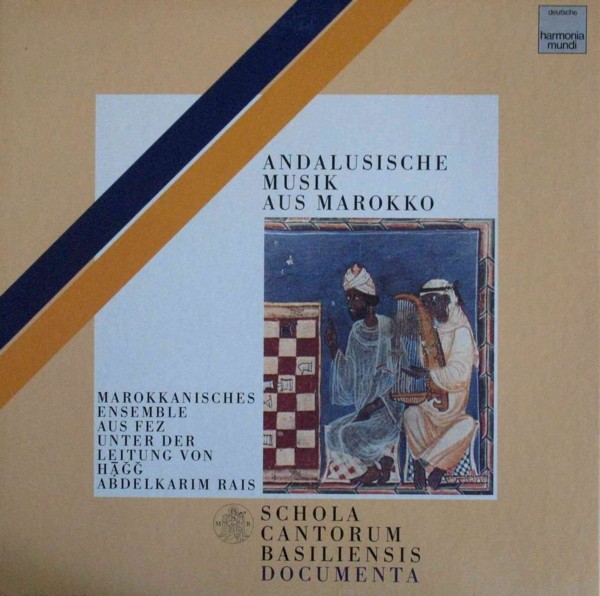
medieval.org
Schola Cantorum Basiliensis Documenta
LP, 1984:
Deutsche Harmonia Mundi (EMI) 1C 16 9525 3 / 1C 2LP 153
CD, 1991:
Deutsche Harmonia Mundi (BMG) “Editio Classica ” GD 77 241
[recorded 1977]
Um den zyklischen Charakter dieser Musik zu wahren,
wurde keine detaillierte Einteilung in einzelne Tracks vorgenommen
In order to preserve the cyclical character of this music,
the recording has not been divided into individual tracks
CD 1
[48.48]
naubatu r-raSdi, mīzānu l-quddāmi
(1.Teil/first part)
al-bugyatu (rhythmisch nicht gebundenes Instrumentalvorspiel)
at-tawshiyatu (rhythmisch gebundenes Instrumentalvorspiel)
aS-San‘atu 1 - al-laylu laylun ‘ajībun („Die Nacht ist eine wunderbare Nacht“) B:93/1 M:166/1
aS-San‘atu 2 - anā qad ‘ayya Sabrī („Meine Standhaftigkeit ist schwach“) B:93/2 M:167/n2
aS-San‘atu 3 - qalbī tarahū yafrahu („Die siehst est, mein Herz ist frölich“) M:167/3
aS-San‘atu 4 - yāTal‘ata al-badri („Oh Schönheit des Vollmondes“) M:167/4
al-baytāni
(Gesangsimprovisation)
aS-San‘atu 5 - katamtu l-maHabbata sinīna („Jahrelang habe ich die Zuneigung verschwiegen“) M:170/15
aS-San‘atu 6 - nahwā mina l-gizlāni („Unter der Gazellen“) B:93/3 M:169/10
aS-San‘atu 7 - al-lā'imu lā yulawwimunī („Der Tadler tadelt mich nicht heftig“) M:390/13
naubatu r-raSdi, mīzānu l-quddāmi
(2.Teil/second part)
aS-San‘atu 8 - awHashat mudh gibta („Es ist einsam du weg bist“) M:176/29
aS-San‘atu 9 - ayyuhā as-sā'ilu („Oh Bittsteller“) M:176/30
aS-San‘atu 10 - ammā qad Hafita („Du warst verborgen“) M:101/2
aS-San‘atu 11 - yā muqābilu („Oh Gegenüber“) B:94/5 M:177/34
aS-San‘atu 12 - yā man malakani ‘abdan („Oh wer mich Diener beherrscht“) B:94/6 M:177/35
al-mawwālu
(rhythmisch nicht gebundene Gesangs- und Instrumentalimprovisation)
aS-San‘atu 13 - tayyahtanī bayna l-anāmi („Du bringst mich in Verwirrung“) B:95/7 M:179/2
aS-San‘atu 14 - qum tarā r-rauDa („Steh auf, betrachte den Garten“) M:178/37
aS-San‘atu 15 - ayyu Zabyin ‘alā l-asadi („Welche Gazelle kämpft mit dem Löwen“) M:215/37
CD 2
[54.25]
naubatu l-māyati, mīzānu l-basīT
al-bugyatu (rhythmisch nicht gebundenes Instrumentalvorspiel)
at-tawshiyatu (rhythmisch gebundenes Instrumentalvorspiel)
aS-San‘atu 1. unZur ‘ilā raunaqi l-‘ashīyati („Sieh den Glanz des Abendhimmels an“) B:37/1 M:352/1
aS-San‘atu 2. al-‘ashīyatu aqbalat bi-l-iSfirāri („Der Abendhimmel wird gelb gefärbt“) B:37/2 M:352/2
al-baytāni
(Gesangsimprovisation)
aS-San‘atu 3. al-‘ashīyatu fi l-iSfirāri („Der Abendhimmel in Gelbfärbung“) B:38/4 M:354/6
aS-San‘atu 4. qum ‘āyini l-‘ashīyata („Steh auf, schau dir den Abendhimmel an“) B:38/5 M:357/7
aS-San‘atu 5. yā ‘ashīyatu („Oh Abendhimmel“) B:39/6 M:355/12
aS-San‘atu 6. unZurú Samsa l-‘ashīyati („Seht die Sonne des Abendhimmels an“) B:39/7 M:355/12
aS-San‘atu 7. qum tarā Samsa l-‘ashīyati („Steh auf, betrachte die Sonne des Abendhimmels“) B:40/8 M:356/13
aS-San‘atu 8. qad ashraqad shamsu l-gabini („Schon scheint die Sonne der Stirne“) B:40/9 M:277/19
naubatu l-māyati, mīzānu l-quddāmi
al-bugyatu (rhythmisch nicht gebundenes Instrumentalvorspiel)
at-tawshiyatu (rhythmisch gebundenes Instrumentalvorspiel)
aS-San‘atu 1. al-‘ashīyatu ilā l-gurūbi („Der Abendhimmel verdunkelt sich“) B:50/1 M:367/1
aS-San‘atu 2. wa-‘ashīyatin („Beim Abendhimmel“) B:50/2 M:367/2
aS-San‘atu 3. jā'a a l-habību („Der Freund ist gekommen“) B:50/3 M:370/12
aS-San‘atu 4. yā sāhibā („Oh Gefährte“) B:51/4 M:369/8
al-mawwālu
(rhythmisch nicht gebundene Gesangs- und Instrumentalimprovisation)
aS-San‘atu 5. a‘Zam yā ‘ashīyatu („Séi erhaben, oh Abendhimmel“) B:51/5 M:369/8
aS-San‘atu 6. shamsu l-‘ashīyi qad garabat („Schon geht die Abendsonne unter“) M:375/30
aS-San‘atu 7. anā kullīyun milkun lakum („Ich bin euch völlig ergeben“ mit interpolierter tawshiyatun) B:51/6
aS-San‘atu 8. samsu l-‘ashīyati raunaqat („Glanzvoll ist die Sonne des Abendhimmels“) B:51/7 M:378/40

Hajj ‘abdelkarim rais, rabab, Gesang/voice
muHammad bajdub, Gesang/voice
sidi samlali, Violin/e, Gesang/voice
muHammad ben hayyun, Violin/e, Gesang/voice
Hajj muHammad buzuba, ‘ūd, Gesang/voice
SaleH sherki, qānūn, Gesang/voice
Hajj muHammad tazi, Tār, Gesang/voice
Hajj ‘abdelahad ‘amri, darābukka, Gesang/voice
Leitung/Direction: HAJJ ‘ABDELKARIM RAIS
rabab :
zweisaitiges Streichinstrument | two-stringed bowed instrument
‘ūd :
Laute | lute
qānūn :
Zither mit trapezförmigem Resonanzkasten | zither with trapezoidal soundbox
tar :
Tambourin mit Schellen | tambourine with jingles
dardbukka :
einfellige Bechertrommel | single-headed goblet drum
 [CD]
[CD]
Ⓟ 1984 harmonia mundi, D-7800 Freiburg
© 1991 Schola Cantorum Basiliensis
Aufnahme/Recording: Robert Lattmann
Aufgenommen/Recorded: 3. 2. 1977
Phonag Tonstudio, CH-8307 Lindau ZH
Kommentar/Liner notes: Thomas Binkley
Übersetzungen/Translations:
Meinrad Schweizer, Anne Smith, Genevieve Begou, Isabel Rodriguez-Nogueras
Titelbild/Front cover picture: Miniatur aus der Cantigas-Handschrift/
Miniature from the Cantigas manuscript
El Escorial, Real Monasterio de El Escorial, T.j.1.
Mit freundlicher Genehmigung des/by kind permission of the
Patrimonio Nacional, Tesoro Artístico, Madrid
Titelbild/Front cover picture Booklet:
Die Tafel zeigt einen Baum mit „Stämmen“ und „Asten“,
der das System der in der „andalusischen“ Musik verwendeten 24
Tonarten darstellen soll. Die vertikal angeordnete Schrift in der Mitte
(hadha shajaratu T-Tubū‘i:
„Das ist der Baum der Tonarten“) bildet den Grundstamm, um den
links und rechts vier „Stamme“ mit ihren „Ästen“
angeordnet sind; der fünfte „Stamm“ (unten in der Mitte) hat
keine „Aste“.
Das Bild ist eines der wenigen Zeugnisse mit
theoretischem Ansatz zur nordafrikanischen Musiktheorie und wird
erstmals von dem Marokkaner muHammad al-Bū‘isāmī (+1690) erwähnt.
Booklet cover illustration: The table shows a tree with “limbs” and
“branches” representing the system of 24 tonalities employed in
“Andalusian” music. The vertically aligned inscription in the center (hadha shajaratu T-Tubū‘i:
“This is the tree of tonalities”) forms the trunk, to the left and
right of which are arranged four “limbs” with their “branches”. The
fifth “limb” (bottom center) has no “branches”.
This illustration is one of the few sources dealing with rudiments of North African
musical theory and was first mentioned by the Moroccan muHammad al-Bū‘isāmī (+1690).
Redaktion/Editing:
Thomas Drescher (SCB)
Dr. Jens Markowsky (dhm)
All rights reserved
HARMONIA MUNDI D-7800 FREIBURG
Eine Co-Produktion mit dem | A co-production with
Westdeutscher Rundfunk Köln
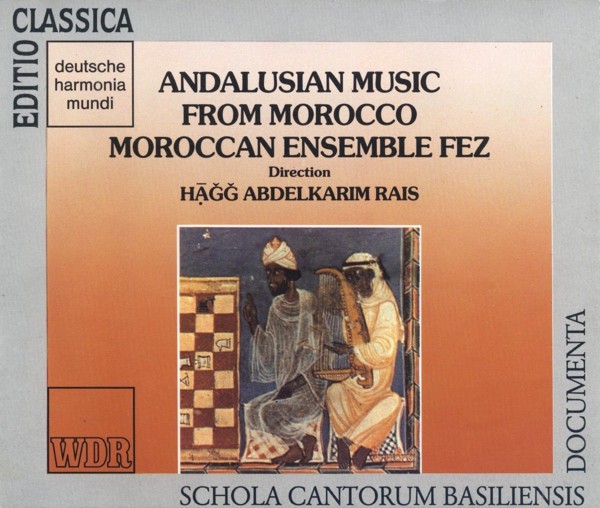
Introduction
This recording cannot fail to stimulate
interest in the history of Western culture as it is preserved in
non-European traditions. Here we take up one fascinating musical
tradition of North Africa, a descendant of medieval Hispano-Arabic music
which migrated to the Moslem Mediterranean world as the Moors were
driven from Spain during the centuries of conflict, the reconquista,
completed by the Catholic kings at the close of the 15th century; a
music which in its pure state is unlike any other Moslem musical
tradition, one which since the 18th century has become stabilized in its
repertory and in its performance practice.
There is a very large
literature concerning the contributions of the Hispano-Arabs to
Christian civilization in languages, sciences and arts, a literature far
too complex and detailed to review here. One tributing is of importance
in charting the awakening of interest in the music of the Maghreb. The
painter Nicolas Jacques Conte (1775—1805) was appointed by Napoleon
Bonaparte to accompany a team of researchers forming an expedition to
Egypt. He was to capture Egypt in countless sketches and paintings of
subjects about which the other team members were to write. The results
of that expedition is contained in the 24 volumes of the remarkable Description de l'Egypte,
10 volumes of text, 14 oversized volumes of plates published in two
editions between 1809-28 and 1821-30. This is a rich source of
information on virtually every aspect of 18th century Egyptian life,
including music. Villoteau's “de l'etat actuel de l'art musical en
Egypte” includes explanations of Maqqam, Ethiopean notation,
improvisation on a single note, Coptic chant, Jewish music, musical
instruments and much more. Conte illustrated this discourse with a great
many plates.
This enormous study stimulated interest in the
music of the non-European Mediterranean world, and led to other works
such as Edward William Lane's mid 19th century An account of the Manners and Customs...
(still in print today) which also touches upon musical practices. Of
more importance for us is Salvador Daniel, who before he was executed
was for a few days the director of the Paris Conservatoire during the
commune of 1871, and who wrote La musique arabe: ses rapports avec la musique grecque et le chant grégorien,
Algiers 1863 / 2nd edition 1879, and later translated into English by
Henry George Farmer, an outspoken defender of the thesis of Arabic
influence on Western music. Daniel included the first — as far as I am
aware — piece of Andalusian music to appear in Western literature, a
piece he called “Heuss-ed-Doure, a Moorish song from Algiers”. Actually
it is a section from the Nouba meia [Núba al-Maya] contained on this
record (see Compact Disc 2).
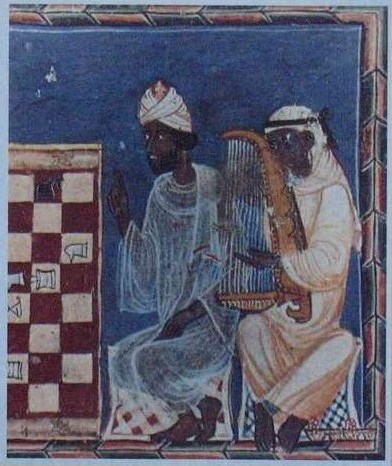 In 1922 a musicological controversy arose with the publication of the Arabist Julian Ribera's La música de las Cantigas (Madrid 1922), followed by La música andaluza medieval en las canciones de trovadores...,
3 vols, 1923-25. Ribera sought the rhythmic solution of the notation of
the Cantigas de Santa Maria in Arabic practices, a standpoint shared
with few music historians. The suggestion of some connection between the
Hispano-Arabic music and the Cantigas has remained alive in spite of
the negative reception of Ribera's thesis. Indeed, interaction between
the Moslem, Jewish and Christian civilizations has been studied
extensively in literature. Nyhl and later Briffault along with many
others defended the Arabic thesis of influence of the Arabs on courtly
love and troubadour lyric. Others supported the opposing theses of
classical heritage, while a few wrote about a spontaneous development.
Le Gentil in a little book about the villancico tried to present the
conflicting theses in perspective. In 1953 Samuel Stern published his
remarkable discovery that the final verses of the Andalusian muwashshahs
were not nonsense Arabic as had been believed, but were written in a
romance language. (Samuel Stern, Les chansons mozarabes: les vers fin aux [kharjas] en espagnol dans les muwashshahs arabes et hébreux...,
Palermo 1953, reprint Oxford 1964). More recently, studies and
translations of Hispano-Arabic literature have proliferated — eg. Garcia
Gómez Todo Guzmán, and the exemplary anthology of James Monroe.
In 1922 a musicological controversy arose with the publication of the Arabist Julian Ribera's La música de las Cantigas (Madrid 1922), followed by La música andaluza medieval en las canciones de trovadores...,
3 vols, 1923-25. Ribera sought the rhythmic solution of the notation of
the Cantigas de Santa Maria in Arabic practices, a standpoint shared
with few music historians. The suggestion of some connection between the
Hispano-Arabic music and the Cantigas has remained alive in spite of
the negative reception of Ribera's thesis. Indeed, interaction between
the Moslem, Jewish and Christian civilizations has been studied
extensively in literature. Nyhl and later Briffault along with many
others defended the Arabic thesis of influence of the Arabs on courtly
love and troubadour lyric. Others supported the opposing theses of
classical heritage, while a few wrote about a spontaneous development.
Le Gentil in a little book about the villancico tried to present the
conflicting theses in perspective. In 1953 Samuel Stern published his
remarkable discovery that the final verses of the Andalusian muwashshahs
were not nonsense Arabic as had been believed, but were written in a
romance language. (Samuel Stern, Les chansons mozarabes: les vers fin aux [kharjas] en espagnol dans les muwashshahs arabes et hébreux...,
Palermo 1953, reprint Oxford 1964). More recently, studies and
translations of Hispano-Arabic literature have proliferated — eg. Garcia
Gómez Todo Guzmán, and the exemplary anthology of James Monroe.
The
existence of Christian-Moslem interaction in literature supports the
notion of interaction in other areas, including music. Whereas in
literature we have the written words in original manuscripts this is not
the case with music, which was largely an unwritten tradition in Spain
in the 13th century. Non-European traditions may shed light upon
important questions where documents are lacking. For example, in a
library of Valencia is the manuscript of a medieval Arabic cookbook from
Spain which purports to contain recipes by Ziryab, that original
musician, artist and bon vivant frequently credited with founding the
Spanish school of Arabic music. These recipes employ culinary techniques
and prepared “fonds” not adequately explained in the text. I was unable
to execute the recipes until James Monroe, who also knew the
manuscript, revealed his discovery to me, that through the study of
contemporary indigenous (i.e. non-French) cooking techniques from
Morocco the problems dissolved. If such study can help with the problems
of medieval cooking practice, perhaps it can help with the music too.
The Studio der frühen Musik (Early Music Quartet) undertook two
expeditions in the Maghreb (with the assistance of the German Goethe
Institute) in the 1960's, which were fruitful in the pursuit of elements
of musical performance practices relevant to the performance of Western
medieval monophony. The results have had a lasting influence on nearly
all subsequent performances of the monophonic repertory, either through
imitation, reflection or rejection. (viz. Basler Jahrbuch für historische Musikpraxis 1; also
the recording Cantigas de Santa Maria, SCB-Documenta, harmonia mundi IC
065-99898 which reflects the Andalusian practice in the performance of
Cantigas).
There are two clear areas where the use of this
Andalusian music is appropriate as a model: performance techniques of an
instrument (all known to have been employed in the West) and the manner
of joining instruments together in the performance of monophonic music.
Of less direct importance are the specific improvisational models
pursued by the Andalusian players and singers, the manner of
constructing preludes, postludes and interludes, and the manner of
grouping poems together into suites accompanied by cyclic rhythms in
predetermined sequences. The origin of the specific repertory is not
relevant to this interest because it is not the material but how it is
presented that is important. It may be too late today to penetrate the
specific ties of this repertory to the medieval past. As we have seen so
often in this century, every erosion of a cultural border dilutes the
traditional music with exotic entries — new instruments, new rhythms, a
new sociology which all bring about irreversible changes in performance.
All
the more valuable, then, that this music has been captured on record,
an unalterable performance of a traditional music which has ties —
however elusive - to the Spanish Middle Ages.
Thomas Binkley
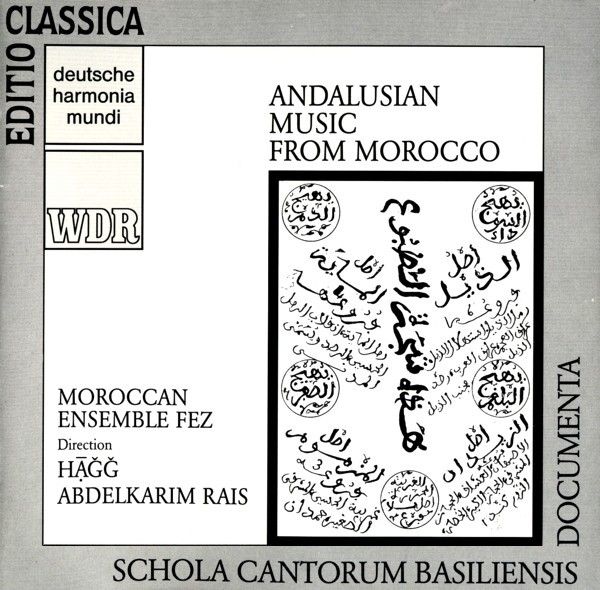
Moroccan music as an aid in the interpretation of medieval songs
The
present recording may be traced back to a “Woche der Begegnung — Musik
des Mittelmeerraumes und Musik des Mittelalters” (“A Week of Exploration
— Mediterranean Music and Medieval Music”) that was held in Basel from
January 31 to February 4, 1977. The focal point of this week was the
encounter of the “Studio der frühen Musik” (Andrea von Ramm, Thomas
Binkley, Richard Levitt and Sterling Jones) with the “Andalusian”
musical practice of North Africa as represented by a leading ensemble
from Fez under the direction of Hājj Abdelkarim Rais. The group's
musicological advisor was Hājj Idress Benjellun, director of the
Association of Friends of Andalusian Music in Morocco (jam‘iyatu hawāti
l-mūsiqū l-andalusīyati, magreb).
The “Woche der Begegnung” consisted
of several concerts performed by both groups, a workshop about the
“Andalusian” musical practice, as well as a musicological symposium
about the “Performance Practice of Medieval Songs” with Wulf Arlt,
Thomas Binkley, Josef Kuckertz (Cologne), Ernst Lichtenhahn, Hans Oesch,
Christopher Schmidt and Habib Hassan Touma (Berlin). The papers
presented at this symposium may be found in the Basler Jahrbuch für historische Musikpraxis I (Amadeus-Verlag, Winterthur, 1977).
The
organizers of the “Woche der Begegnung” were the Schola Cantorum
Basiliensis and the Musicological Institute of the University of Basel
in collaboration with the Basel section of the Schweizerische
Musikforschende Gesellschaft and the Verein der Freunde alter Musik of
Basel.
The “Studio der frühen Musik” had the opportunity of
becoming acquainted with a musical practice which only recently has
departed from its unwritten tradition, as is the case with the
“Andalusian” music from Morocco, and of investigating how what they
learned could be used in their study of the performance practice of
non-liturgical, monophonic songs from the Middle Ages. Here the problem
lies in the realization of the extant written material — in which the
(relative) pitches of the monophonic melodies is notated and underlaid
with the text of one strophe of the song — in sound, a process involving
rhythmic specification, the textual underlay of further strophes of the
song and the addition of instruments. The “Andalusian” musical
practice, one which has an unwritten tradition, could be of assistance
here because of the geographical as well as the historical and cultural
connections between “Andalusian” music from Morocco and the medieval
song from southwest Europe. It is, however, particularly difficult to
reconstruct these connections in the field of music in that there is no
direct information from the Middle Ages about the “Andalusian” musical
practice, whereas the inverse holds for the material with which it is to
be compared. On the one hand our contact with the medieval song is
through an abstract notation, whose informational content is such that
our ability of producing an historically accurate realization is
limited, while, on the other hand, “Andalusian” music sounds today and
is a part of a musical tradition whose historical dimensions are far
from being clarified. The “Woche der Begegnung” thus remained an
experiment, one which by no means provided new solutions to the problems
of performance practice, but one, however, which made one aware of
those features, outside the realm of historical knowledge, of a real,
sounding musical practice which may have been lost.
“Andalusian” music
Recent
research about Arabic music distinguishes two main traditions of Arabic
art music, one associated with an eastern and the other with a western
region (Northwest Africa). In such studies the western tradition is
generally called “Andalusian” music under the justified assumption that
this art music now cultivated in North Africa was once an art whose home
was in southern Spain. Its origins, because of the occupation of the
Iberian peninsula by Islamic peoples (Arabian al-andalus, land of the wandalun,
of the Vandals), are thought to extend back to the court of [the]
Abbas[sids] in Baghdad. Reference is made, as direct evidence of such a
tradition, to a musician from Baghdad by the name of Ziryab who
emigrated to Spain in the 9th century and brought much innovation in the
field of music with him. The information in these sources concerning
matters of musical practice as well as of theory and terminology,
however, is totally inadequate for making a comparison with today's
musical practice. The first direct evidence we know of showing an
immediate connection with today's musical practice comes from the 17th
and 18th centuries. On the one hand this consists of the specification
of the names of the 24 keys by Muhammad al - būiSāmī (+ 1690) (Cf. the
Comments about the frontispiece) and, on the other, of the collection of
poems by muHammad al-Hā'ik, which was commissioned by the Moroccan
ruler, Muhammad b. ‘Abdallah (who reigned from 1757-1790). This
collection of song texts still constitutes the basic repertory of
“Andalusian” music today. A thorough study of the contents, a
classification of the repertory, as well as an identification of the
poets in the manuscripts, which are now mostly located in Morocco, all
have yet to be undertaken.
The repertory of “Andalusian” music
“Andalusian” music in Morocco has a clearly defined repertory which is subdivided into eleven sets of songs (so-called naubātun, sing.: naubatun) and instrumental pieces. In order to more explicitly specify a naubatun, the name of the key primarily used, such as al-māyatu, ar-raSdu, is appended. Further, each naubatun has 5 parts, whereby each part is accompanied by a basic rhythmic pattern (mizānun, pl.: mawāzinun). The parts are called by the names of these rhythmic patterns:
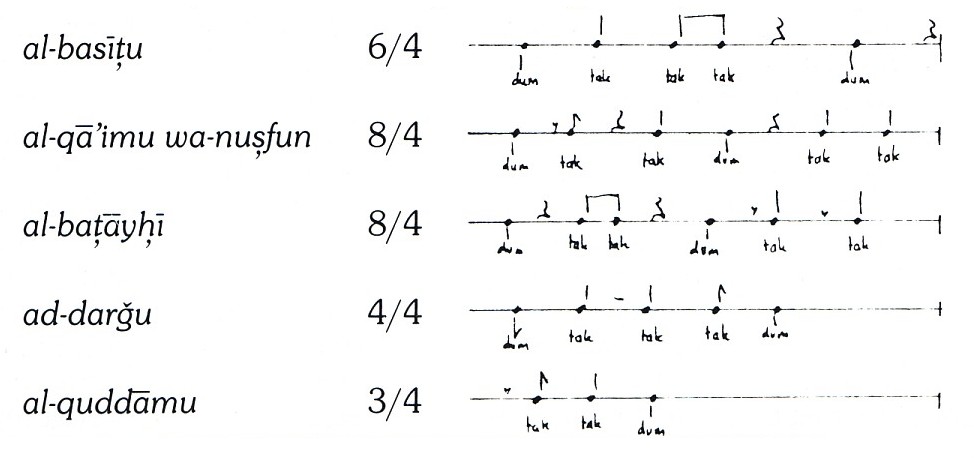
Basic form (“dum”: low note, “tak”: high note)
During
the performance of a section, the rhythmic pattern is played repeatedly
while the tempo is gradually being increased. On top of this framework,
songs (Sanā‘tu, sing.: San‘atun) with instrumental accompaniment are executed with instrumental preludes and interludes (tawshshiyatun). At the beginning of each naubatun there is an instrumental piece called a bugyatun which is tied to no rhythmic pattern. The bugyatun has the function of establishing the main melodic mode of the entire naubatun. Additional pieces, such as the baytāni and the mawwāl may be interpolated in the individual sections. The baytāni
is a vocal improvisation on two lines of text which is not tied to a
specific rhythm. The singer, in addition to the two lines of text, uses
the meaningless syllables “ha na na” to extend his improvisation. The mawwāl is an improvisation undertaken by the singer and the players of melodic instruments. Like the baytāni this improvisation is not tied to a rhythmic pattern and has the same improvisatory character. It differs from the baytāni
in that before and between the vocal sections, which are performed by
the singer alone, individual instrumentalists execute their own
improvisations.
The main components of each naubatun are the songs, muwashshahun and zajalun which have been set to music — poems which have been allotted to specific naubatun
on the basis of their content. Descriptions of nature, such as of
sunrises and sunsets or the beauty of plants, social gatherings over
wine, longing for one's distant lover, and praise for the Prophet
Muhammad are the main themes found in these poems.
As far as the
form is concerned, the musical settings of the poems are based upon
their strophic form; for the most part they have a seven-line strophe,
AABBBAA. This seven-line strophe consists of one three-line section,
which has a rhyme of its own (BBB), and of two two-line sections with a
rhyme in common (AA), which enclose the three-line section. Based upon
this strophic form, five-line poems are usually performed, ones which
lack the first two-line section (AA). This results in the rhyme scheme
of BBBAA. Subdivisions within the lines which coincide with internal
rhymes are significant in determining the form of the musical setting,
particularly in the first line of the two-line section. The individual
half lines and lines are thus associated with specific melodic sections
in a fixed order, whereby the following sequence is valid for the
strophic form BBBAA:
Melodic Section I: first line (B) and instrumental repetition
Melodic Section I: second line (B) and instrumental repetition
Melodic Section I: third line (B)
Melodic Section II: fourth line up to internal rhyme, instrumental repetition
Melodic Section II: second half of fourth line (A)
Melodic Section I: fifth line (A).
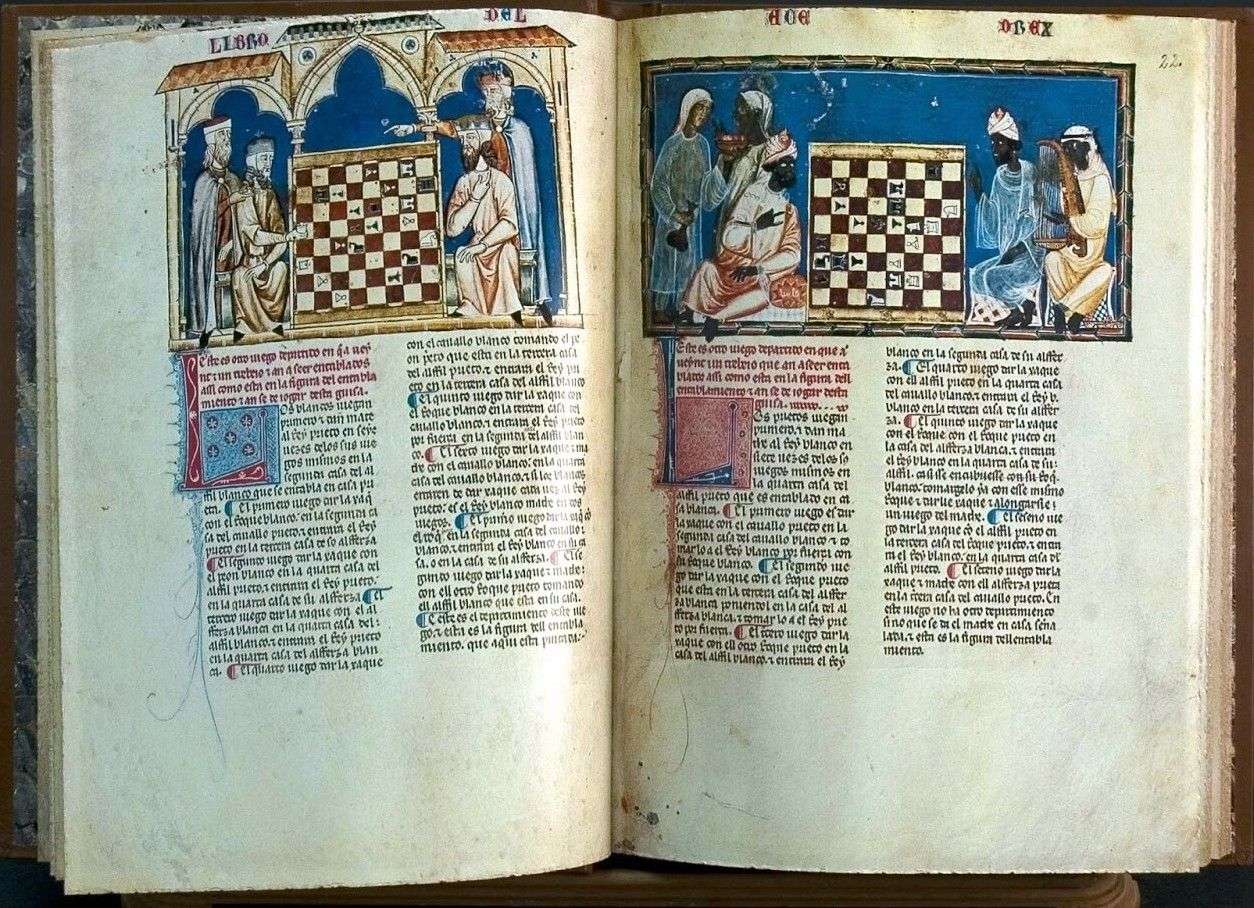
SCHOLA CANTORUM BASILIENSIS - DOCUMENTA
After
more than half a century the Schola Cantorum Basiliensis (SCB) and the
concept on which it is based have lost none of their relevance today.
Founded in 1933 by Paul Sacher, this “Lehr- und Forschungsinstitut für
alte Musik” at the Music Academy in Basle has remained unique in many
respects. From the time it opened until today, musicians prominent in
the development of the performance of early music, in which historical
practices are taken into account, have gathered together there.
Music
from the Middle Ages to the beginning of the 19th century is studied at
the SCB. Research, teaching, concerts, and publications are always
closely connected with one another because of the cooperation between
musicians and musicologists.
Some of the important subjects dealt
with at events and in editions sponsored by the SCB are preserved on
this series of recordings. The performers and the authors of the
commentaries are usually affiliated with the Institute.
The
purpose of the series is to document the significant initiatives made by
the SCB in the field of early music and to make them available to a
larger audience.


 [CD]
[CD]
 In 1922 a musicological controversy arose with the publication of the Arabist Julian Ribera's La música de las Cantigas (Madrid 1922), followed by La música andaluza medieval en las canciones de trovadores...,
3 vols, 1923-25. Ribera sought the rhythmic solution of the notation of
the Cantigas de Santa Maria in Arabic practices, a standpoint shared
with few music historians. The suggestion of some connection between the
Hispano-Arabic music and the Cantigas has remained alive in spite of
the negative reception of Ribera's thesis. Indeed, interaction between
the Moslem, Jewish and Christian civilizations has been studied
extensively in literature. Nyhl and later Briffault along with many
others defended the Arabic thesis of influence of the Arabs on courtly
love and troubadour lyric. Others supported the opposing theses of
classical heritage, while a few wrote about a spontaneous development.
Le Gentil in a little book about the villancico tried to present the
conflicting theses in perspective. In 1953 Samuel Stern published his
remarkable discovery that the final verses of the Andalusian muwashshahs
were not nonsense Arabic as had been believed, but were written in a
romance language. (Samuel Stern, Les chansons mozarabes: les vers fin aux [kharjas] en espagnol dans les muwashshahs arabes et hébreux...,
Palermo 1953, reprint Oxford 1964). More recently, studies and
translations of Hispano-Arabic literature have proliferated — eg. Garcia
Gómez Todo Guzmán, and the exemplary anthology of James Monroe.
In 1922 a musicological controversy arose with the publication of the Arabist Julian Ribera's La música de las Cantigas (Madrid 1922), followed by La música andaluza medieval en las canciones de trovadores...,
3 vols, 1923-25. Ribera sought the rhythmic solution of the notation of
the Cantigas de Santa Maria in Arabic practices, a standpoint shared
with few music historians. The suggestion of some connection between the
Hispano-Arabic music and the Cantigas has remained alive in spite of
the negative reception of Ribera's thesis. Indeed, interaction between
the Moslem, Jewish and Christian civilizations has been studied
extensively in literature. Nyhl and later Briffault along with many
others defended the Arabic thesis of influence of the Arabs on courtly
love and troubadour lyric. Others supported the opposing theses of
classical heritage, while a few wrote about a spontaneous development.
Le Gentil in a little book about the villancico tried to present the
conflicting theses in perspective. In 1953 Samuel Stern published his
remarkable discovery that the final verses of the Andalusian muwashshahs
were not nonsense Arabic as had been believed, but were written in a
romance language. (Samuel Stern, Les chansons mozarabes: les vers fin aux [kharjas] en espagnol dans les muwashshahs arabes et hébreux...,
Palermo 1953, reprint Oxford 1964). More recently, studies and
translations of Hispano-Arabic literature have proliferated — eg. Garcia
Gómez Todo Guzmán, and the exemplary anthology of James Monroe.

